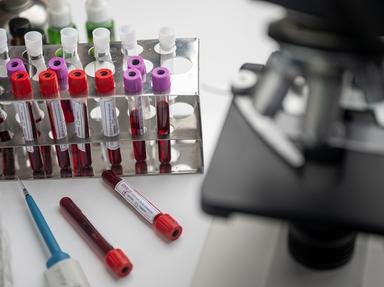Quiz Answer Key and Fun Facts
1. As suggested by their name, amino acids are acidic. What is the name of the functional group (circled) which confers this acidity on amino acids?
2. The amino group (circled) is another important and defining functional group in amino acids. How many of the nitrogen atom's valence (outermost) electrons are involved in chemical bonds?
3. Every amino acid has what is known as an "R group" (circled). What can the R group also be called?
4. The acid group, the amino group, the R group, and the hydrogen atom are all bonded to a central carbon atom (circled). What name is given to this carbon atom?
5. When amino acids are in solution, they exist as charged molecules, with a negative charge on the acidic group and a positive charge on the amino group. What name is given to this molecule?
6. The R group may also be able to lose or accept hydrogen ions and therefore provide the amino acid with a net charge. How will lysine (pictured) usually behave in water (pH7)?
7. Amino acids can be divided into groups based on the chemical properties of their R groups. Which group does isoleucine (pictured) belong to?
8. In order to make proteins, amino acids must join together. This reaction involves the loss of a hydrogen ion from the amino group of one amino acid, and the loss of a hydroxyl group from the acidic group of another. What is this reaction known as?
9. The bond which results from the joining of two amino acids is chemically special since it is halfway between a single and a double bond. What name is given to this bond?
10. The chemical bond between amino acids is capable of forming several hydrogen bonds, which are essential to protein folding and protein function. Of the atoms present in this chemical bond, which atom is most likely to function as a hydrogen bond donor?
Source: Author
doublemm
This quiz was reviewed by FunTrivia editor
WesleyCrusher before going online.
Any errors found in FunTrivia content are routinely corrected through our feedback system.

